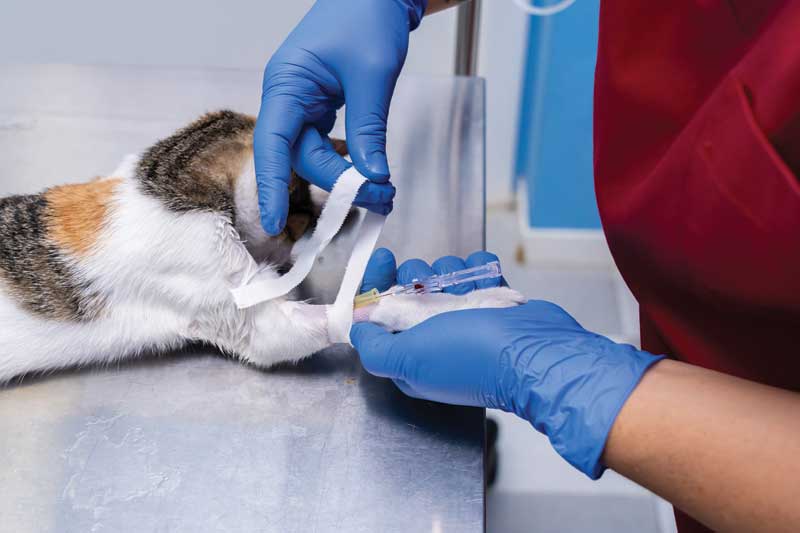
Ignaz Semmelweis, a Hungarian doctor, known as the “father of hand hygiene,” noticed the women giving birth in his hospital were more likely to develop a fever and die compared to the women giving birth in the nearby midwife-run maternity ward.
Dr. Semmelweis observed doctors often visited the maternity ward after performing autopsies earlier in the day. He derived a theory the doctors performing autopsies got “cadaverous particles” on their hands, which they then carried from the autopsy room into the maternity ward.1 Since midwives did not conduct surgery or autopsies, they were not exposed to these particles. As a result, Semmelweis mandated handwashing with chlorine for doctors. Death dates in his maternity ward fell dramatically.
In the 1870s, this was the first proof handwashing could prevent infection.
Infection control and prevention is an important part of the entire veterinary team’s role, yet is commonly overlooked. Hospital-acquired infections (HAIs), also known as nosocomial infections, are due to a break in infection control and prevention protocols.
Our best efforts in care can be destroyed by a protocol violation, which may not only impact the patient’s health, but also the client’s financial, social, and emotional well-being.
It is important to recognize the risks within your practice, have the appropriate disinfectant and PPE for the biosecurity level of the environment you are working in, and have continuous team training on infection control.
More than just a habit
Creating infection control and prevention safeguards, such as standard operating procedures (SOPs), can help prevent HAIs within a practice by 10-70 percent.2 Making SOPs within your hospital, training staff to help improve infection control, and making even an initial 10 percent-
20 percent improvement can make a huge difference on your overall patient care and owner’s financial well-being.
It is important to note everyone within the practice has a role and responsibility in infection control and prevention. Communicate what role each team member should take to help prevent HAIs and collaborate with one another on each SOP for the hospital to ensure each team member feels included, valued within the process, and will find the importance of infection control and prevention (Figure 1).

Additionally, it can be beneficial to dedicate an infection control and prevention coordinator within your practice to organize, coordinate, and champion the program you wish to put in place. This individual may be coordinating the new hire training to discuss the specific SOPs for the hospital. They may have a small segment during staff meetings to discuss updates on new protocols or safeguards being put in place. This individual may be the one who is responsible for writing the SOPs for the hospital after much research from the team.
This role is extremely important as we see science is constantly evolving. New disinfectants have continued to evolve throughout history and will continue to grow. New protocols will continue to change, and someone in this role should be open to learning and growing, adapting to change, and training and developing others.

Common associated infections
Studies have found HAIs occur within 48 hours of hospitalization.3 The most common infections seen have been with intravenous catheters (peripheral and central venous catheters), urinary catheters, ventilator-associated pneumonia, and infection due to dirty fluid lines.3 It is crucial SOPs are in place to ensure that teams are following the same aseptic protocols when nursing their patients (Figures 2 and 3). If an emergency occurs, and the ability to follow aseptic technique cannot occur, it is imperative to either replace the catheter when the patient is stable aseptically or monitor and clean the site closely. If there are any signs of infection, replace the catheter immediately.

Summary
If there is a break in our infection control and prevention system, even our best efforts in patient care and treatment will not be enough to keep our patients from getting HAIs. It is important to have established SOPs, regular training for all team members, checklists in place that are completed by team members, appropriate PPE usage, knowledge of cleaning and disinfecting agents, and most importantly, compliance of all team members in handwashing procedures. Establishing designated areas for infectious patients, as well as immunocompromised patients, is important to maintain patient safety from HAIs.
Utilizing appropriate PPE for patients that are immunocompromised, infectious, or even when handling bodily fluids maintains a separate line of defense within our infection control and prevention system. Even if we can help improve a small number of infections within our hospitals in a short amount of time, that is still a great improvement in patient care.
Infection control and prevention change within a hospital takes the entire hospital to participate and commit to change. This is a team effort for the overall patient well-being. Ask yourself if you are ready to wash your hands of HAIs.

For more SOPs on infection control and prevention, access the 2018 AAHA Infection Control, Prevention, and Biosecurity Guidelines.
Beth Armstrong, CVT, CVBL, CFE, CCFP, CFT, CTP, FT, works with clinical teams on their personal and professional development, while creating new leaders with collaborative teamwork. Educating has always been one of her passions, where after spending many years teaching at multiple veterinary technology colleges in the Chicagoland are, Armstrong now owns her own business, VTNE Prep, mentoring students through their journey through credentialing.
References
- The Global Handwashing Partnership. The Global Handwashing Partnership -. (2022, September 26). https://globalhandwashing.org/about-handwashing/history-of-handwashing/
- Harbarth S, Sax H, Gastmeier P. The preventable proportion of nosocomial infections: an overview of published reports. J Hosp Infect 2003; 54(4):258–66
- Hospital-acquired infections – statpearls – NCBI bookshelf. (n.d.-a). https://www.ncbi.nlm.nih.gov/books/NBK441857/
- Veterinary practice guidelines 2018 Aaha Infection Control, prevention … (n.d.). https://www.aaha.org/globalassets/02-guidelines/infection-control/icpb_guidelines.pdf
